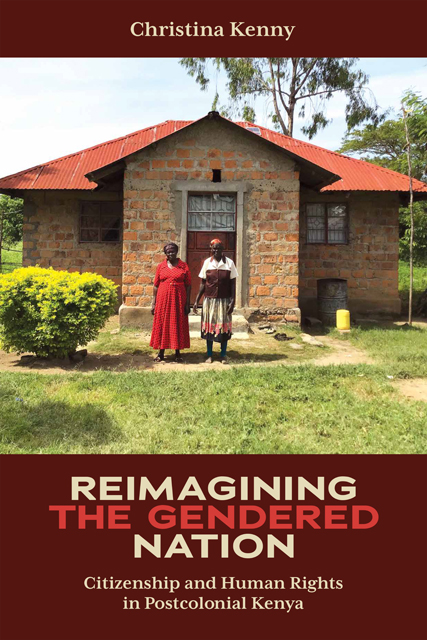Book contents
- Frontmatter
- Dedication
- Contents
- List of Illustrations
- Acknowledgements
- Note on Ethnic Identities
- List of Abbreviations
- Introduction
- 1 The Kenya Colony in British East Africa: A History of Ethno-patriarchy
- 2 Bodies as Battlefields, Bodies as Weapons: The Colonial Regulation of Women’s Bodies
- 3 Myths of Sorority: Kenyan Women’s Community Organisation
- 4 Everyday Violence: Violence against Women during Elections and Times of Peace
- 5 Gendered Citizenship, Politics and Public Space: Women’s Participation in Government
- Conclusion
- Appendix: Field Work, Focus Groups and Interviews
- Bibliography
- Index
- Eastern Africa Series
2 - Bodies as Battlefields, Bodies as Weapons: The Colonial Regulation of Women’s Bodies
Published online by Cambridge University Press: 17 December 2022
- Frontmatter
- Dedication
- Contents
- List of Illustrations
- Acknowledgements
- Note on Ethnic Identities
- List of Abbreviations
- Introduction
- 1 The Kenya Colony in British East Africa: A History of Ethno-patriarchy
- 2 Bodies as Battlefields, Bodies as Weapons: The Colonial Regulation of Women’s Bodies
- 3 Myths of Sorority: Kenyan Women’s Community Organisation
- 4 Everyday Violence: Violence against Women during Elections and Times of Peace
- 5 Gendered Citizenship, Politics and Public Space: Women’s Participation in Government
- Conclusion
- Appendix: Field Work, Focus Groups and Interviews
- Bibliography
- Index
- Eastern Africa Series
Summary
‘In the village, most of Zakariah’s circumcision mates were already married and they used to boast to him about their beautiful wives and even more about their children … [I]t was true that they had attractive young and charming wives who made them feel like men. These women were friendly but shy, ready to obey and attended their husbands with respect. They never answered back their husbands like Mrs Smith. Their husbands were little lords in their houses, and not baby sitters like Mr Smith. Indeed, there were many things to envy these men for. Still, many wives had a lot to learn about looking after babies, cleanliness, and being able to talk.’
Throughout the colonial period, both indigenous communities and the colonial authorities fought for control of the bodies of African women and girls in Kenya, as women’s bodies were (and remain) primary sites of cultural identity formation and expression. Indeed, the level of control over women’s reproductive potential, labour, migration, hygiene, health and clothing became indicators of the success of the British civilising mission. Both the ritual and the results of body modification have served as conscious markers of difference not only between Kenyans and colonialists, but also within and between indigenous Kenyan ethnic groups. Given the unrelenting focus on women’s bodies, the regulation and attempted eradication of female genital cutting (FGC) is, unsurprisingly, a recurring theme in the history of colonial Kenya and was at the centre of existential struggles between the colonial regime and the ethnic communities that practise it. In the Kenyan context, resistance to FGC and the promotion and perpetuation of the practice have been interpreted as the two halves of a dichotomy. However, Kenyan women’s motivations are much more complex than merely supporting either colonial or cultural authority.
Here, I examine three instances in which female genital cutting was a central issue in political contests during the colonial period, focusing on how women’s public, political statements relied upon their sexed bodies and gendered identities. These alternative accounts trouble earlier histories which interpreted these acts as statements of proto-feminist autonomous action, directed towards the liberation of African women from the compound patriarchal burdens of both the colonial regime and their own ethnic communities.
- Type
- Chapter
- Information
- Reimagining the Gendered NationCitizenship and Human Rights in Postcolonial Kenya, pp. 40 - 71Publisher: Boydell & BrewerPrint publication year: 2022



